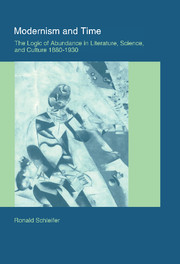Book contents
- Frontmatter
- Contents
- Preface
- Introduction:Post-Englightment Modernism and the experience of time
- PART I POST-ENLIGHTENMENT APPREHENSIONS
- 1 The Enlightenment, abundance, and postmodernity
- 2 Temporal allegories: George Eliot, Walter Benjamin, and the redemption of time
- 3 The second Industrial Revolution: history, knowledge, and subhectivity
- PART II LOGICS OF ABUNDANCE
- Notes
- References
- Index
3 - The second Industrial Revolution: history, knowledge, and subhectivity
Published online by Cambridge University Press: 22 September 2009
- Frontmatter
- Contents
- Preface
- Introduction:Post-Englightment Modernism and the experience of time
- PART I POST-ENLIGHTENMENT APPREHENSIONS
- 1 The Enlightenment, abundance, and postmodernity
- 2 Temporal allegories: George Eliot, Walter Benjamin, and the redemption of time
- 3 The second Industrial Revolution: history, knowledge, and subhectivity
- PART II LOGICS OF ABUNDANCE
- Notes
- References
- Index
Summary
If the French Revolution were to recur eternally, French historians would be less proud of Robespierre. But because they deal with something that will not return, the bloody years of the Revolution have turned into mere words, theories, and discussions, have become lighter than feathers, frightening no one. There is an infinite difference between a Robespierre who occurs only once in history and a Robespierre who eternally returns, chopping off French heads.
Let us therefore agree that the idea of eternal return implies a perspective from which things appear other than as we know them: they appear without the mitigating circumstance of their transitory nature.
Milan Kundera, The Unbearable Lightness of Being (1984: 4)As I mentioned in chapter 1, the decades before and after the turn of the twentieth century have come to be described by many as the second Industrial Revolution, the transformation in Western Europe and America of the relatively small-scale industrialism of entrepreneurial or industrial capitalism to large-scale finance capitalism. This period created an enormous increase in consumable wealth — personal income among Parisian workers, for instance, increased about 65 percent in the two generations after the mid-nineteenth century, advertising revenues in the United States during the same period increased tenfold (Birkin 1988: 118, 120), and there was an explosion of technologically advanced consumer goods such as bicycles, automobiles, telephones, domestic electric lighting, and the like (Kern 1983; see also Tipton and Albrich 1987) in a period that, a generation ago, Carleton Hayes called “the climax of the Enlightenment” (1941: 328). “By 1900,” Oron Hale notes, “Europe was the center of a booming world economy”; it was experiencing one of those discontinuous leaps forward in technology and invention which had marked the industrial progress since the mid-eighteenth century.
- Type
- Chapter
- Information
- Modernism and TimeThe Logic of Abundance in Literature, Science, and Culture, 1880–1930, pp. 108 - 146Publisher: Cambridge University PressPrint publication year: 2000



